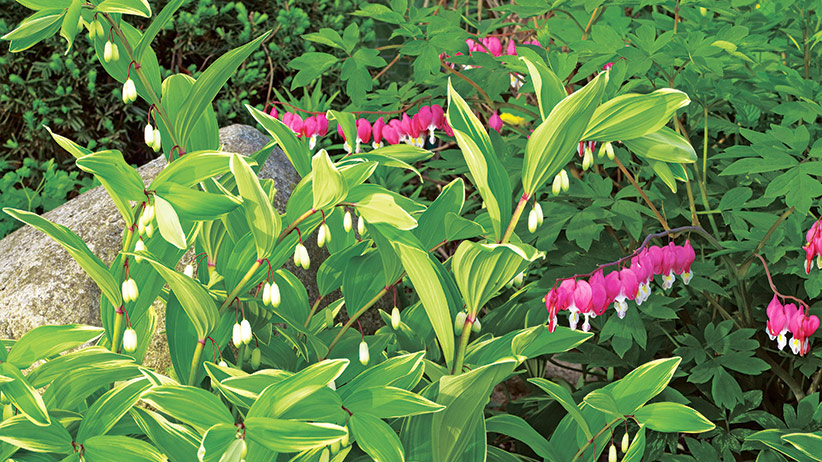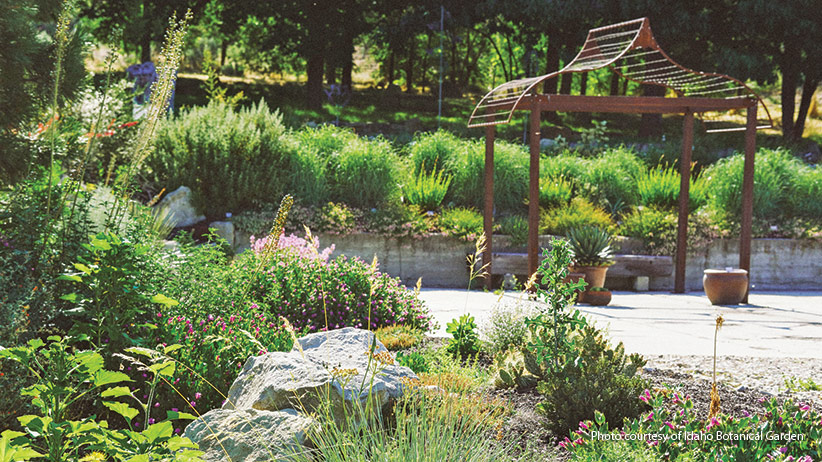
Play with the Autumn Palette
Here’s an autumn pairing to inspire daydreams of your summer snorkeling adventures; don’t you think the amaranth looks like underwater coral? And the hyacinth bean petals are like shimmering scales of swimming fish! Majestic scarlet plumes dominate this combo, but dainty dancing lavender-and-pink flowers add sparkle. After the flowers come eye-catching royal purple bean pods. For an additional pop of color, the amaranth foliage changes to deeper red in fall, glowing orange when it catches the light.
Growing tips
- Give the hyacinth bean a trellis to climb and these tall plants become bosses in the back of the border.
- When the purple bean pods mature and dry, harvest the seeds inside. You can plant them again in spring, but soak them overnight before planting.
- The amaranth may need staking, especially if it’s in a windy location.
- Direct sow amaranth seeds in spring and thin to 18 to 24 inches apart.
- The amaranth doesn’t need much water, and poor soil means stronger foliage color.
- Amaranth seeds can be harvested, cooked and eaten; they’re very similar to quinoa. If you don’t like them, the birds will!
A) Amaranth (Amaranthus cruentus ‘Oeschberg’)
Type Annual Blooms Scarlet red spikes midsummer through fall and dark crimson-purple foliage Light Full sun to part shade Size 3 to 4 ft. tall, 2 to 3 ft. wide Hardiness Heat-tolerant in AHS zones 12 to 1
B) Hyacinth bean (Lablab purpureus)
Type Tender perennial (usually grown as an annual) Blooms Twining purple or white flowers in summer and fall Light Full sun to part shade Size 10 to 20 ft. tall, 3 to 6 ft. wide Hardiness Cold-hardy in USDA zones 10 to 11, heat-tolerant in AHS zones 12 to 1
See more Plant combos

Mix in leafy greens
The saturated purple foliage of Swiss chard is the thrilling complement to the sunny yellow celosia. Dimpled matte Tuscan kale foliage and Swiss chard’s glossy-smooth appearance emphasize the celosia’s feathery texture.
Growing tips
- Swiss chard and Tuscan kale are technically biennials but are usually grown as annuals.
- Plant them in the middle of summer for a stunning combo in fall.
- Pinch back the flowers of the Swiss chard to keep the plant producing fabulous foliage.
A) Celosia (Celosia argentea cristata ‘Kimono Yellow’)
Type Tender perennial (usually grown as an annual) Blooms Yellow plumes spring to fall Light Full sun Size 6 to 9 in. tall, 5 to 7 in. wide Hardiness Cold-hardy in USDA zones 10 to 11, heat-tolerant in AHS zones 12 to 1
B) Tuscan kale (Brassica oleracea ‘Black Magic’)
Type Biennial Blooms Long, dimpled blue-green foliage; blooms in the second year Light Full sun to part shade Size 18 to 24 in. tall and wide Hardiness Cold-hardy in USDA zones 7 to 11, heat-tolerant in AHS zones 12 to 1
C) Swiss chard (Beta vulgaris ‘Bright Lights’)
Type Biennial Foliage Mix of red, pink, orange, white or gold stems and purple or green leaves Light Full sun to part shade Size 12 to 16 in. tall, 8 to 10 in. wide Hardiness Cold-hardy
in USDA zones 7 to 11, heat-tolerant in AHS zones 12 to 1
See also Flowers & Plants
















